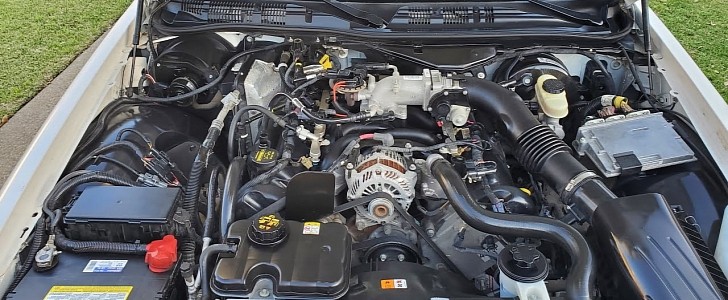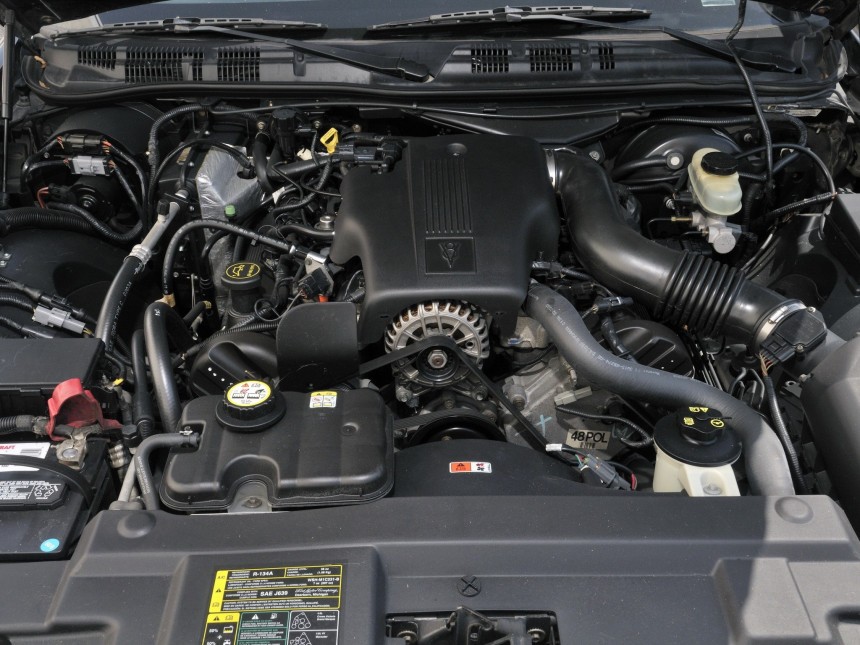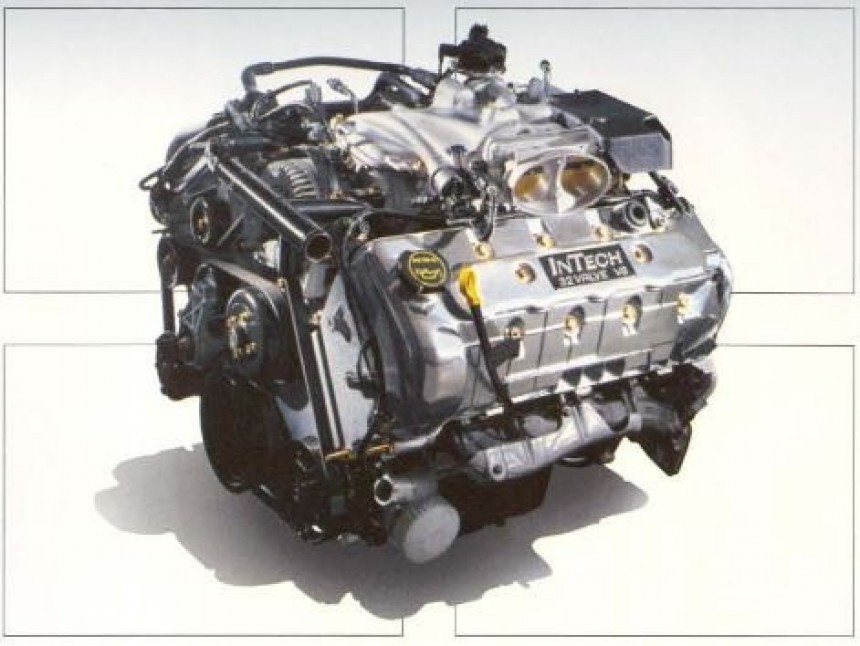More so than in any other car-producing nation, there is and has been a disconnect between what the American auto industry believes its customers want to buy and what they actually want to buy. Whether or not it works out in the end when a finished product hits the market is a real case-by-case basis.
In the case of the Ford 4.6 Modular V8, famous for its use in the Crown Victoria and all its Panther platform buddies, it took decades for the American public to warm up to it. Here's the story of the most misunderstood American engine of the last 30 years. It'll showcase just how out of touch Ford used to be with their fanbase.
The late 1980s and early 90s were a transformative period for the cars driving on America's interstates. Gone was the effective monopoly of the three biggest car companies in the nation headquartered in Detroit, Michigan. Unlike the 60s, there was competition from all corners of the globe on America's roads. This is especially true when it comes to Japanese cars.
During this period, Americans were finally beginning to warm up to the idea of smaller engines and using forced induction to make more power. Traditionally, this issue was solved with cubic displacement and little else in the states. Be it the Toyota 1J, a Honda D-engine with VTEC, or even the KA24 engine in the Nissan 240SX, American car buyers were quickly learning the virtues of small, high-revving JDM engines.
As Brian of Regular Car Reviews on Youtube said so eloquently in his 2003 Mercury Marauder review, which was vital for our research for this article, even Ford themselves released a double-overhead-cam, four-valve per cylinder V6 engine designed by Yamaha, and expressly made for Taurus SHO back in 1988. With that in mind, when Ford introduced the second generation of the iconic Panther platform, you'd forgive the public for assuming something similar to the Taurus SHO was destined for its engine bay.
But alas, that previously mentioned disconnect between American automakers and the American public was about to rear its ugly head. Featured under the hood of early-90s Ford Crown Victorias, the Mercury Grand Marquis, and the Lincoln Town Car was not a Taurus SHO engine, in spite of the familial resemblance between them. Instead, it was that a single-overhead-cam, two-valve-per-cylinder, lethargically revving 4.6-liter Modular V8 that had more in common with American engines of old it replaced than it did anything out of the JDM scene.
So then, if the American public craved high-tech, high-revving turbocharged smaller engines optimized for exuberant driving, it was clear Ford thought what they actually wanted was simple, dependable, slow-revving American-style V8s, intended for low RPM cruising and not much else. With that in mind, you'd be forgiven for thinking Americans wouldn't want anything to do with Ford's Panther platform or the 4.6 Modular V8.
But as lovers of the platform will tell you, that's not at all what happened. Though the Modular V8 was down as much as 30 horsepower from the equivalent Taurus SHO with 190 compared to 220, the Modular V8 had one ace up its sleeve. It was as reliable and durable of a V8 engine as Ford or any other domestic manufacturer had produced in the last 40 years.
With such a primitive but easy-to-maintain SOCH, two-valve design combined with modern goodies like electric port-fuel injection and OBD computer diagnostic capability, it was the perfect combination for American law enforcement and taxi services, working with industries that couldn't afford to have an expensive and complicated turbo V8 in the shops for constant repairs. When the name of the game isn't always about raw speed, the old dog that was the Modular well and truly came into its own. Later 4.6 two-valve Modular V8s produced as much as 240 horsepower, which surely helped with acceleration in larger, facelifted late model vehicles on the old Panther platform.
Even so, Ford eventually got around to sprinkling the 4.6 Modular platform with some of the performance-oriented features consumers had initially wanted. Novel drivetrains with three or even four valves per cylinder would be introduced, using the old Modular platform in vehicles like the mid-2000s F-150, E-Series Vans, the SN-95 Mustang in many high horsepower variants like the Mach 1, the Mercury Mountaineer and Ford Explorer, all manner of different Lincolns, and even the absolute zenith of the Panther platform, the Mercury Marauder.
Under the hood of the Marauder, the four-valve per cylinder, dual overhead-cam 4.6-liter Modular V8 jetted out 302 horsepower. Keep in mind that the chances of that not being underrated are pretty slim. In reality, it probably produced anywhere between 320 and 330 horsepower. It may have taken the better part of 15 years, but the Ford 4.6 Modular V8 did eventually find its footing in the end, with the manufacturing of the Panther platform there-in not ceasing until 2011, before one last hurrah in an E-Series van in 2014.
Check back soon for more from V8 Month right here on autoevolution.
The late 1980s and early 90s were a transformative period for the cars driving on America's interstates. Gone was the effective monopoly of the three biggest car companies in the nation headquartered in Detroit, Michigan. Unlike the 60s, there was competition from all corners of the globe on America's roads. This is especially true when it comes to Japanese cars.
During this period, Americans were finally beginning to warm up to the idea of smaller engines and using forced induction to make more power. Traditionally, this issue was solved with cubic displacement and little else in the states. Be it the Toyota 1J, a Honda D-engine with VTEC, or even the KA24 engine in the Nissan 240SX, American car buyers were quickly learning the virtues of small, high-revving JDM engines.
As Brian of Regular Car Reviews on Youtube said so eloquently in his 2003 Mercury Marauder review, which was vital for our research for this article, even Ford themselves released a double-overhead-cam, four-valve per cylinder V6 engine designed by Yamaha, and expressly made for Taurus SHO back in 1988. With that in mind, when Ford introduced the second generation of the iconic Panther platform, you'd forgive the public for assuming something similar to the Taurus SHO was destined for its engine bay.
So then, if the American public craved high-tech, high-revving turbocharged smaller engines optimized for exuberant driving, it was clear Ford thought what they actually wanted was simple, dependable, slow-revving American-style V8s, intended for low RPM cruising and not much else. With that in mind, you'd be forgiven for thinking Americans wouldn't want anything to do with Ford's Panther platform or the 4.6 Modular V8.
But as lovers of the platform will tell you, that's not at all what happened. Though the Modular V8 was down as much as 30 horsepower from the equivalent Taurus SHO with 190 compared to 220, the Modular V8 had one ace up its sleeve. It was as reliable and durable of a V8 engine as Ford or any other domestic manufacturer had produced in the last 40 years.
With such a primitive but easy-to-maintain SOCH, two-valve design combined with modern goodies like electric port-fuel injection and OBD computer diagnostic capability, it was the perfect combination for American law enforcement and taxi services, working with industries that couldn't afford to have an expensive and complicated turbo V8 in the shops for constant repairs. When the name of the game isn't always about raw speed, the old dog that was the Modular well and truly came into its own. Later 4.6 two-valve Modular V8s produced as much as 240 horsepower, which surely helped with acceleration in larger, facelifted late model vehicles on the old Panther platform.
Under the hood of the Marauder, the four-valve per cylinder, dual overhead-cam 4.6-liter Modular V8 jetted out 302 horsepower. Keep in mind that the chances of that not being underrated are pretty slim. In reality, it probably produced anywhere between 320 and 330 horsepower. It may have taken the better part of 15 years, but the Ford 4.6 Modular V8 did eventually find its footing in the end, with the manufacturing of the Panther platform there-in not ceasing until 2011, before one last hurrah in an E-Series van in 2014.
Check back soon for more from V8 Month right here on autoevolution.












